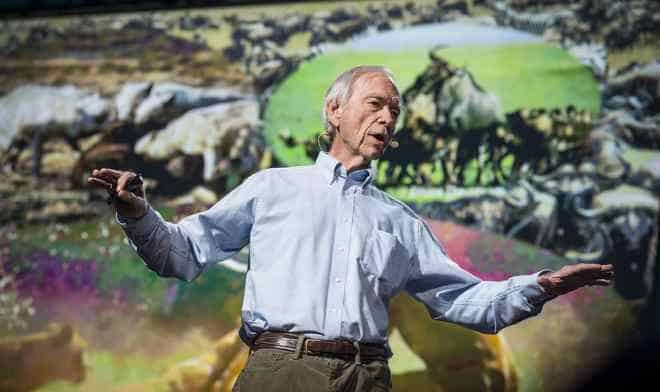The United Nations has declared 2010 to 2020 the “Decade for Deserts and the Fight Against Desertification.” Allan Savory, a Zimbabwean biologist and this week’s Food Hero, is a leader in one the most innovative methods to reverse desertification: holistic management and planned grazing.
Livestock and livestock keepers are often blamed for desertification. Livestock occupy around 30 percent of non-frozen land, and by 2050, global cattle population may increase from 1.5 billion in 2000 to 2.6 billion. In his TED Talk, How to green the world’s deserts and reverse climate change, Savory disputes conventional wisdom, and calls for large herds of livestock to mimic nature in a heavily monitored process called holistic management.
Two-thirds of the world is facing desertification, and recent research by the United Nations Desertification Convention (UNCCD) indicates that severe land degradation impacts 168 countries, destroying an area greater than the size of Pennsylvania each year.
This leads to faster water evaporation from the soil, and the elimination of natural carbon sinks, Savory asserts that desertification is just as much a cause of climate change as the use fossil fuels. And desertification reduces agricultural production, contributing to hunger particularly in sub-Saharan Africa.
Savory was first faced with desertification while building national parks in Zimbabwe in the 1950s. He, along with other scientists, initially believed the desertification was caused by large herds of elephants, leading to a decision that Savory described as the “saddest and greatest blunder of my life.” Savory helped construct a policy that led to the slaughter of 40,000 elephants, whose population levels are now vulnerable. The culling of elephants and other mega fauna made Savory, in his own words, “absolutely determined to devote my life to finding solutions.”
The historical solutions supported by traditional environmentalists to reverse desertification—including reducing livestock populations and controlled burns—have proven extremely ineffective. In fact, Savory notes that, “burning one hectare of grassland gives off more, and more damaging, pollutants than 6,000 cars. And we are burning in Africa, every single year, more than one billion hectares.” Large herds of animals are critical to grasslands because they provide nutrients for the soil. Predators force herds to rapidly move across grasslands, trampling the ground and aiding in the decay of grasslands between growing seasons. Without large herds, the land oxidizes, which smothers and kills grasses, leaving bare soil and releasing carbon.
Savory declares that, “there is only one option […] And that is to use livestock, bunched and moving, as a proxy for former herds and predators and mimic nature.” Called holistic management, this method requires precise planning of livestock herd movements and grazing patterns in areas faced with desertification.
The results have been staggering.
From Africa to South America, holistic management has seen increased crop yields and the reversal of desertification. Savory highlighted the impact of increasing livestock by 400 percent and planning grazing land in Zimbabwe. The result was a healthy ecosystem with little fear of dry spells.
Holistic management has also led to increased crop yield; in Patagonia, a flock of 25,000 sheep led to a 50 percent increase in the production of the land in the first year. Areas that had lost over 30 centimeters of soil and were barren were returned to healthy ecosystems without any signs of desertification.
Savory has created the Africa Centre for Holistic Management and the Savory Institute to help facilitate the implementation of holistic management around the world. Reversing desertification on half of the world’s grasslands would store enough carbon to “take us to pre-industrial levels,” says Savory.















